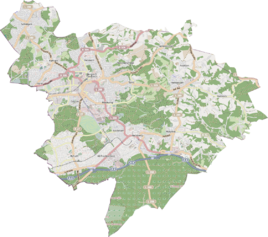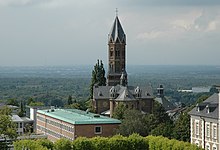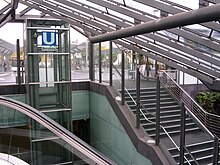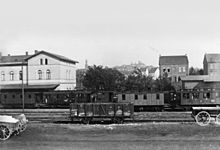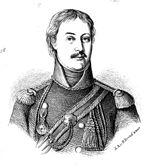Bensberg
|
Bensberg
City of Bergisch Gladbach
|
||
|---|---|---|
| Coordinates: 50 ° 57 ′ 56 ″ N , 7 ° 9 ′ 25 ″ E | ||
| Height : | 140 (88–190) m above sea level NN | |
| Area : | 3.66 km² | |
| Residents : | 5725 (December 31, 2017) | |
| Population density : | 1,564 inhabitants / km² | |
| Incorporation : | 1st January 1975 | |
| Incorporated into: | Bergisch Gladbach | |
| Postal code : | 51429 | |
| Area code : | 02204 | |
|
Location of Bensberg in Bergisch Gladbach |
||
|
Bensberg, general view from the Kardinal-Schulte-Haus of the old and the new castle
|
||
Bensberg is a district of Bergisch Gladbach and belongs to the statistical district 5 of the city under No. 52.
Location and description
Bensberg is located in the south of the city of Bergisch Gladbach and borders the cities of Cologne , Overath and Rösrath . A special attraction is the new Bensberg Castle , now a luxury hotel where the star chef Joachim Wissler works. Not far away is the castle-like old castle with the town hall , which was built between 1962 and 1972 according to plans by the architect Gottfried Böhm for the then city of Bensberg.
history
Bensberg, called Bainsbur, Bensbure, Behnsburg or also Painspurg in old writings , was probably built around a Franconian castle in the area of a royal forest in Deutzgau towards the end of the early Middle Ages . Bensberg was first mentioned in a document in 1139. According to an older publication provided to Engelbert I of Berg in 1170 robber barons , as Gauerben the castle used to have the market and put for the county mountain in possession. The Bergisch Burgvogt Curt von Arloff defended the castle in 1198 against Bohemian mercenaries who roamed and plundered in the Rhineland as part of the crown dispute between Philip of Swabia and Otto IV . In an “ acta apud Bensburg ” from 1218, the church there, which was located in the Decanate Tuytiensis in Rhineland-Franconia, was named as the mother church of Immekeppel .
According to current historians, the Old Bensberg Castle is said to have been built by the Landgraves of Thuringia at the end of the 12th century and shortly thereafter passed to the Counts of Berg.
The castle complex from this period served the Counts of Berg as a residence from the 13th century onwards , as the Bergisch rulers constantly changed their seat of government in their country. Bensberg Castle, which was initially used by the Counts of Berg to develop the country, was later developed as a residential castle and, like other sovereign castles owned by the sovereigns, was used by the counts and later dukes of Berg to rule the Bergisches Land from here. From 1218, Engelbert I , Archbishop of Cologne, one of the most powerful imperial princes of his time, used Bensberg Castle, as he was able to rule both territories from here, due to the proximity to Cologne. During his stay in Italy he was appointed imperial administrator by Friedrich II and appointed guardian and tutor of the young king's son Heinrich, whom he crowned King Heinrich VII in Aachen in 1222 . He remained his guardian until his death, making him the politically strongest person in the empire.
From the middle of the 14th century the office “ Bainsbure ” can be proven. At this time, in addition to Bensberg, the villages of Bergheim , Burscheid , Dürscheid , Herkenrath , Immekeppel , Lülsdorf , Mundorf, Odenthal , Paffrath , Porz , Stammheim , Refrath and Volberg belonged to this office. The courts in the official area were in Bensberg, Porz and Odenthal. After that, during the rule of the Duchy of Berg , Bensberg belonged to the Porz office but remained the seat of the waiter . When the ruling families had money problems, parts of the area were pledged more often. One of these pledges was that of July 26, 1413. Count Adolf von Berg pledged the Bensberg office to Duke Rainald von Jülich-Geldern for a period of 6,400 French kroner .
Bensberg experienced its first economic boom with the construction of the new castle at the beginning of the 18th century, when Duke Johann Wilhelm II. (Popularly: Jan Wellem) had a baroque hunting lodge built in the immediate vicinity of his hunting ground, the royal forest . In the French era , from 1807 to 1813, Bensberg had the administrative status of both canton Bensberg and Mairie Bensberg in the arrondissement of Mülheim am Rhein in the Rhine department of the Grand Duchy of Berg . After the Congress of Vienna , the Grand Duchy became part of the Prussian Rhine Province . Mairie Bensberg became the mayor's office in Bensberg in the Mülheim am Rhein district in 1816 , until it became the municipality of Bensberg in 1927.
City of Bensberg
In 1947 Bensberg received city rights. After the Second World War, people moved from the city of Cologne to the countryside in Bensberg and the surrounding area. Especially in the west of the then urban area, in the districts of Refrath, Frankenforst and Lustheide, numerous new building areas have been built since the end of the 1950s. Cologne tried to counteract this emigration and to reintegrate the emigrants through incorporation plans. As part of the local reorganization , from 1964 onwards, numerous proposals for reorganization were made at local, regional and state level. “Secret plans” initially caused heated discussions at the local level. The regional director, the district president, several experts, the city of Cologne, the city of Bergisch Gladbach, the city of Bensberg and the interior minister made suggestions for the reorganization. Until recently, the city of Bensberg resisted a city merger with Bergisch Gladbach. A constitutional complaint was rejected in Münster in 1976.
District of Bergisch Gladbach
When the municipal reorganization came into force on January 1, 1975, Bensberg lost its independence; the former urban area has since largely belonged to Bergisch Gladbach (49.25 km², 41,958 inhabitants); smaller parts were incorporated into the communities Overath (6.87 km², 2773 inhabitants), Kürten (4.86 km², 1918 inhabitants, including the town of Dürscheid ) and Rösrath (0.69 km², 44 inhabitants) (see also: Cologne Law ).
With the merger, new structures had to be organized. First of all, residential spaces were introduced , some of which no longer corresponded to the earlier parts of the city that were “felt” by the residents . On November 3, 2015, the Bergisch Gladbach City Council decided to convert these residential areas into districts. Today, Bensberg, together with the districts of Bockenberg , Kaule , Moitzfeld , and Lückerath, forms the statistical district 5 .
The Bergisch Gladbach city archive not only secures the historical tradition of the city of Bergisch Gladbach (old and new city) and its districts and predecessor communities, but also of the former city of Bensberg. The city archive, located in the Stadtmitte district , makes these archives accessible to the public and also publishes its own series of books on the city's history.
Witch hunt
In 1602 eight women were burned as witches in Bensberg, including five from Odenthal and one woman from the "Bloemengut" in Nittum. Agnes Polwirth was sentenced to death in 1612 and Katharina Güschen in 1613 , all from Nittum. The accused Christina Kirschbaum hanged herself in the Bensberg witch tower after multiple tortures. A part of the still handed-down minutes reports on the trial against Katharina Güschen. The then mayor Gottfried Borken directed the proceedings. After a year imprisonment in the Bensberg Hexenturm, Katharina Güschen was hanged and burned on January 10, 1613, “on the Steinenbrückchen”, not far from Bensberg-Lustheide. In Bensberg there is a memorial plaque on the town hall (Wilhelm-Wagener-Platz) to commemorate the witch trials.
Mining
The term Bensberger Erzrevier , which extended around Bensberg, comes from the scientific discussion of geology . New smelting techniques made it possible to smelt the previously unused zinc blende . As a result, mineral resources were searched for in the vast area. These activities and searches for mineral resources went hand in hand with the onset of industrialization . This led to a significant increase in population. In the literature that is currently available on the subject of the Bensberg ore district, 143 mines are described, many of which were consolidated with additional mine fields . Today ore mining is of no importance. With the closure of the Weiß mine on December 1, 1957, mining in the former urban area of Bensberg and the wider area came to an end. The Lüderich mine was closed in 1978 as the last mine in the Bensberg ore district .
Mining literature
Gerhard Geurts , Herbert Ommer and Herbert Stahl have written the following books as main authors on mining in the Bensberg ore district :
- The legacy of the ore - The White Mine. Bergisch Gladbach 2003, ISBN 3-00-011243-X
- The legacy of ore, Volume 2, The pits on the Gangerz deposits in the Bensberg ore district. Cologne 2004, ISBN 3-00-014668-7
- The legacy of ore, Volume 3, The pits in the Paffrath Kalkmulde. Bergisch Gladbach 2006, ISBN 3-932326-49-0
- Das Erbe des Erzes, Volume 4, Der Lüderich, Bergisch Gladbach 2008, ISBN 3-932326-52-0
- Das Erbe des Erzes, Volume 5, New News and Stories about the Bensberg Erzrevier, Bergisch Gladbach 2014, ISBN 978-3-00-044826-3
population
According to official statistics, on June 30, 2017, Bensberg had 5703 inhabitants. The age group over 65 years with 1681 inhabitants was significantly stronger than the age group under 18 years with only 800 inhabitants.
Mayor 1809–1974
- 1809–1812 Mathias Josef Hubert Stucker
- 1812–1813 Josef von Couven
- 1813–1820 Franz Heinrich Fauth
- 1820–1824 Stefan Boecker
- 1824–1837 Joseph Wessel
- 1837–1840 Heinrich Wessel
- 1840–1874 Carl Wachendorff
- 1874–1882 Theodor Heider
- 1882 Adalbert Karl Hugo Mund
- 1882–1890 August Heinrich Stabenow
- 1890–1908 Karl Joseph Rausch
- 1908–1918 Karl Klee
- 1918–1921 Wilhelm Darius, alderman
- 1921–1934 Friedrich Zander
- 1934–1939 Walter Kappes
- 1940–1945 Hermann Hasberg
- 1944–1945 Bertram Schumacher, entrusted with the exercise of the office
- 1945 Wilhelm Darius
- 1945–1946: Matthias Kiel
- 1946–1956: Jean Werheit
- 1956–1974: Ulrich Müller-Frank senior
City directors 1946–1974
- 1946–1947 Anton Klaes
- 1947–1949 Theodor Hötter
- 1949–1970 Wilhelm Wagener
- 1971–1974 Alexander Lammers
Culture
With the Bensberg Puppet Pavilion , Bensberg has been home to one of the most famous stationary puppet theaters in the Rhenish-Bergisch region since 1988 . It was founded at the time by the puppeteer Heide Hamann.
gastronomy
According to the Michelin Guide and other restaurant guides, Bensberg is home to one of the 10 best restaurants in Germany: the “Vendôme” in Schloss Bensberg, under the direction of top chef Joachim Wissler .
Sports
Bensberg has several sports clubs, for example the two soccer clubs FC Bensberg 02 and SC 27. TV Bensberg is a successful gymnastics club. In particular, his basketball department, whose first women's team played for a long time in the 1st women's basketball league , and the youth work (including a second and a third place in German championships), is known nationwide. The Grün-Gold Bensberg tennis club currently plays in the second division and has David Prinosil, a former Davis Cup player, in its ranks. The Saaler Mühle ice rink is the venue for ESV Bergisch Gladbach, which is also known for its youth work.
Sacred building
- catholic parish church of St. Nicholas
- Evangelical Church Bensberg
schools
- Albertus-Magnus-Gymnasium Bensberg
- Otto Hahn High School Bensberg
- Otto Hahn Secondary School Bensberg
- Johannes Gutenberg Secondary School Bensberg
- Catholic Primary School Bensberg (Eichelstraße)
- Evangelical Primary School Bensberg (Gartenstrasse)
traffic
tram
With the Cologne light rail line 1(Bensberg - Köln-Weiden) you can reach Cologne city center in about half an hour. The line ended earlier at Falltorstrasse. In May 2000, the tunnel was put into operation to extend the route by 487 meters to the Bensberg bus and underground station . A feasibility study was commissioned in 2017 for an extension of the line via the technology park to Herkenrath and Spitze .
railroad
There used to be the Bensberg train station in the Olefant district on the Cologne-Mülheim-Lindlar railway line , which was at the level of today's car dealership on Kölner Strasse, and a railway depot . The line has been closed in this section since 1965. The problem with the Bensberg train station was that it was outside the much higher inner city and was therefore impractical for passenger traffic. The station building was torn down, the old embankment can still be seen today.
For years there has been a very controversial discussion in Bergisch Gladbach about whether a city motorway should be built from the A4 to the center of Bergisch Gladbach over the railway embankment .
Sons and daughters of the former city
Only personalities are listed here who were born in the former town of Bensberg up to December 31, 1974 and who therefore have Bensberg as their place of birth on their identity cards.
- Rüdiger Baldauf , jazz trumpeter
- Marcus Barsch , radio presenter
- Oliver Bäte , manager
- Wolfgang Bergsdorf , political scientist
- Hermann von Budde , Prussian officer and minister in the German Empire
- Dennie Christian , pop singer
- Serge Corteyn , fusion musician
- Jürgen Engel , diplomat, ambassador to Jamaica
- Jakob Euler , master carpenter, member of the Reichstag
- Richard Hamann (Medical Officer)
- Helene Hammelrath , Member of Parliament (SPD)
- Gerhard Hebborn , politician (CDU)
- Götz Heidelberg , physicist and entrepreneur
- Waldemar Henrici , officer
- Alban Nikolai Herbst , writer, librettist
- Marie-Luise Heuser , philosopher
- Oscar Heym , lawyer and writer
- Wolfgang Kirsch , manager
- Kurt Kluxen , historian
- Wolfgang Kluxen , philosopher
- Claudia Knape , world and European champion in motorboat racing
- Witch Köbes , original
- Theo Koll , journalist and moderator
- Brigitte Kraus , athlete
- Georg Küpper , legal scholar
- German Mäurer , Prussian writer
- Max Morsches , mathematician and genealogist
- Claudia Nemat , management consultant and manager
- Handan Özgüven , German politician
- Herbert Ommer , mining historian
- Bernhard Peters , political scientist
- Monika Piel , journalist
- Ingeborg Poffet , improvisation musician and composer
- Julius Rütgers , entrepreneur
- Carl Philipp von Schatte , administrator of the Palatinate Elector
- Karin Sander , artist
- Monika Schwarz-Friesel , cognitive scientist
- Herbert Stahl , folklorist
- Simon Stockhausen , composer
- Ferdinand Stucker , freedom fighter during the coalition wars
- Herbert Watterott , sports journalist
See also
- Bensberg Circle
- Emilie Schmitz
- Emily fountain
- Bensberg earthquake station
- Falltorstrasse
- Hardt nature reserve (Bergisch Gladbach)
- Vincent Pallotti Hospital
- Weyerburg
literature
- Johann Bendel : Heimatbuch des Landkreis Mülheim am Rhein, history and description, legends and tales , Cologne-Mülheim 1925
- Veronika Darius: The architect Gottfried Böhm. Buildings from the sixties . Düsseldorf: Beton-Verlag 1988 (Baumeisterforum).
- Albert Eßer (ed.): Bergisch Gladbach city history . Bergisch Gladbach 2006
- Paul Falk: 75 years of carnival in Bensberg . Bergisch Gladbach 1979
- Willi Fritzen: The old count and ducal residence of Bensberg . Bergisch Gladbach 1985
- Kurt Kluxen: History of Bensberg . Paderborn 1976
- Peter Köster: City marriage - The reorganization of Bensberg and Bergisch Gladbach 1964-1976 . Bergisch Gladbach city archive. Contributions to the history of the city of Bergisch Gladbach Volume 6. Bergisch Gladbach 1999. ISBN 3-9804448-3-X
- Lothar Speer: The first mention of Bensberg in the document from 1138/1139. Who did Bensberg Castle belong to in the 12th century? . In: Heimat between Sülz and Dhünn 12, 2005, pp. 4–8
Web links
- www.lust auf Bensberg.de - "Schlossstadt Bensberg"
- www.erdbebenstation.de - Bensberg earthquake station of the University of Cologne
- www.bensberg-im-blick.de - Bensberg and region - views - prospects - events
Individual evidence
- ^ City of Bergisch Gladbach, The Mayor, Statistics Service (ed.): Selected population structure data . December 31, 2017, p. 7 ( population data including households [PDF; 82 kB ; retrieved on November 17, 2018] A compact overview (as of December 31, 2017) contains the current population structure data according to individual districts (formerly: residential places)).
- ^ Andree Schulte: Bergisch Gladbach, Stadtgeschichte in Straßenennamen , Bergisch Gladbach 1995, p. 313ff., ISBN 3-9804448-0-5
- ↑ a b Vinzenz Jakob von Zuccalmaglio , in: Die Vorzeit der Länder Cleve-Mark, Jülich-Berg and Westphalen. 1837, fourth issue, p. [183] 169.
- ^ In: Annals of the Historical Association for the Lower Rhine . 1873, issue 25, p. [195] 189.
- ^ AJ Binterim, JH Mooren, in: The Archdiocese of Cologne up to the French state upheaval . 1892, p. [20] XIV.
- ↑ In: Kölner Stadt-Anzeiger online edition of May 29, 2016. Article Lothar Speer . Bergisch Gladbach / Bensberg Castle
- ^ In: Annals of the Historical Association for the Lower Rhine . 1873, issue 25, p. [196] 190.
- ^ In: Annals of the Historical Association for the Lower Rhine . 1873, issue 25, p. [197] 191.
- ↑ Martin Bünermann, Heinz Köstering: The communities and districts after the municipal territorial reform in North Rhine-Westphalia . Deutscher Gemeindeverlag, Cologne 1975, ISBN 3-555-30092-X .
- ↑ Residential areas become districts: After 17 years, the council decided to restructure the Bergisch Gladbach area. Kölner Stadt-Anzeiger, local edition for Bergisch Gladbach from November 24, 2015
- ↑ Hetty Kemmerich: Says what I should confess , Dortmund 2004, pp. 179ff, 288, 291.
- ↑ Erika Münster-Schröer: Witch persecution in Jülich-Berg and the influence of Johann Weyer , in: Spee Jahrbuch 2000, Trier 2000, p. 81.
- ↑ Anton Jux: A witch burning on the Hagdorn in 1612 , in: Bergischer Calendar 1959, pp. 90-92.
- ↑ Main Committee City Council Bergisch-Gladbach, February 9, 1988 and March 20, 1990: Decision to put up a memorial plaque at the Bensberg town hall for the women who were innocently mocked, tortured and executed as witches. With illustration. (PDF; 1.6 MB), accessed on September 5, 2017
- ^ Statistics - City of Bergisch Gladbach. Retrieved July 26, 2017 .
- ↑ a b City Archives: Mayor and City Directors accessed on March 16, 2015

